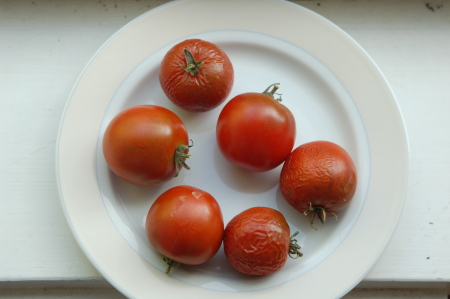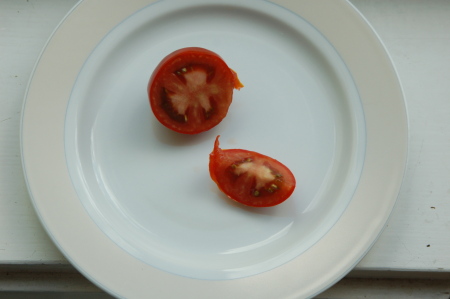Roger of KGI recently made a post on a campaign he started to encourage people to celebrate the upcoming Independence day in the US by featuring local foods. As well as promoting the idea of eating locally, he also addresses the idea of food independence, or food sovereignty as it’s known outside of the US. It’s a really important concept, and it’s important for everyone living everywhere on the planet.
It’s the idea you are able to grow your own food without inputs or outputs of any kind, and without depending on anyone else for anything. Without needing to get into your SUV and drive to Walmart to buy lumber, large bales of peat, mulch, sacks of fertilizers and so on. Without needing to buy seeds from a single source because you grow hybrid varieties produced by a single company. Without needing to use tap water, because you collect rainwater from your roof. Without needing to use landfill space, because you recycle all of your own garden waste. Without using power tools that run on fossil fuels, pollute the air and generate greenhouse gasses. Without needing money to pay for it all.
Of course few people manage to achieve all of these things simultaneously, but by thinking about these things, doing the best you can given your personal circumstances and continuing to work on and improve the way you garden, you are taking an important first step.
A useful way to think about this is the way you spend money on your garden. Growing fruits and vegetables should be almost free. You will need some hand tools, if your ground is acidic some lime and maybe some potting soil from time to time, but everything else comes down to recycling things from your own garden and growing methods. In the short term other things may be needed, for example you may decide to purchase a greenhouse and a shed. You may have some specific problems in your garden that need to be addressed, one of the most common is soil lacking something that can be identified with a soil test or other methods. You may have drainage problems that need to be fixed, and so on. There aren’t many problems that require treatments or inputs beyond a year or two, and you should be thinking about garden sovereignty after that time.
When you buy food from the supermarket, you immediately find yourself in the middle of a complex tangle of commercial interests and politics. It begins because few people know how to grow their own food today, and in part it’s because food companies have invested tremendous effort into making modern foods convenient and cheap. It’s a vicious cycle that’s hard to break. Growing your own food is something that takes time to learn, and this lack of knowledge is really a serious problem.
Nearly all varieties of fruits and vegetables are patented and produced by one of five seed and chemical companies worldwide. Since these same companies also sell chemicals, and they make more money if they sell chemicals with their seeds, so they breed them specifically to need these chemicals. We are all familiar with GM Round Up ready varieties, and this is one very obvious example as Monsanto sells both Round Up and the Round Up ready varieties of seed. There are many, many much more insidious examples of this for example cucumbers susceptible to mildew diseases or insect pests that require chemicals.
When farmers buy commercial seeds to plant, they get a list of required chemicals and a schedule for applying them. Agriculture by numbers, if you like. If farmers don’t do this the seed companies won’t support them. It’s like doing something that invalidates a consumer warranty, even if it has nothing to do with some unrelated problem that needs to be fixed. Under these circumstances, you can be assured farmers will apply all the required chemicals even if they know they aren’t needed.
If you buy certified organic food, you are still buying these commercial varieties. In this case, you pay for the patents on the varieties and the work that went into them being designed to need chemicals, the extra trouble the farmer has to go through to grow them without chemicals, finally the very cumbersome associated paperwork and regulations intended to put small farmers and food producers at a disadvantage. It’s a silly way to buy your food.
If you buy meat, this tangle gets even more intense, because first the grains are grown like I described above, then the animals are raised following similar lines of logic.
This is what we call the Green Revolution.
It came about because during the depression of the 30s and the war years that followed, there were food shortages and they need to ensure food companies who invested in improved plant varieties and production methods could be assured of profits. They invested in plant varieties, chemicals and methods that made them as much money as possible and there were no other reasons for what they did. There’s no reason to believe, if they hadn’t instead invested in organic agriculture without chemical and energy inputs, productions yields would be any lower today than they are now.
When politicians talk about providing ‘high quality’ seeds to the developing world to fight hunger, they are lying. It’s as simple as that. Instead what they are talking about is forcing a system of debt, dependence and environmental damage on hungry people who are in desperate need of developing their own food sovereignty.
If you go to a garden center and buy a normal commercial packet of seeds, you immediately put yourself in the middle of this tangle of required chemicals and politics. It’s not that it’s impossible to grow nice things from commercial seed packets, but you’re starting off at a disadvantage.
If you think along the lines of food sovereignty, and avoid commercial seeds, you’re assured chemicals will not be needed to grow your plants. Otherwise the situation is less clear.
In order to be sure to avoid the usual commercial tangle, if you want to purchase non-commercial seeds, you should purchase them from a company that specialized in them. The best thing would be if you can find a local company, that hopefully produces seeds most suitable for your local climate. In any case, be sure to look specifically for a company that specializes in non-commercial seeds. The links page on this blog lists a number of these companies.
If you grow non-commercial seeds, another advantage is being able to save and replant seeds from these plants. Saving seeds is also a skill that’s been lost with our current generation and takes some time to learn. Many people start reading about how complicated it is and are quickly discouraged. It really doesn’t have to be difficult. Roger’s post that I linked to at the top, discusses growing garlic, something that doesn’t take any special skills to save and replant. Beans, peas and lettuce are nearly as easy. Just grow the plants and save the seeds — that’s it. Other plants can be more complicated but a little research is all that’s needed to learn how to do it. You must however start with non-commercial seeds, or the plants you get after saving your seeds will not be the same as the original parent plants.
Once you make the decision to start saving your seeds, you have access to the wonderful world of seed exchanges. These are fellow gardeners who also save their own seeds, and often have very special varieties of plants on offer. While some of these gardeners are happy to provide their seeds to anyone and everyone, most really expect you to have the intention of saving and regrowing them, so it’s best to at least have the intention of doing this before getting involved in trading this way. If you’re interested in offering or receiving non-commercial seeds, have a look at the Bloggers Seed Netork page.
Aim for food sovereignty. Don’t add anything unnecessarily to your garden. Get away from the mindset of being a farmer, and needing a box of this and a bottle of that. Don’t give your money to the wrong companies. Grow the right varieties. Take care of our planet and your health, at the same time you grow fresh fruits and vegetables in your own garden.








